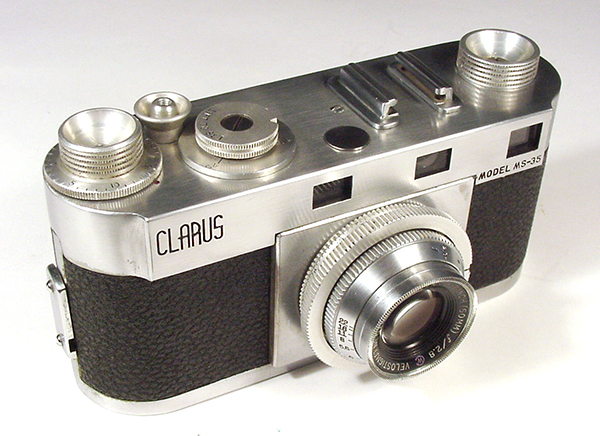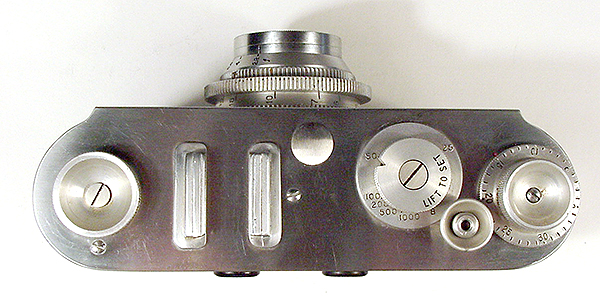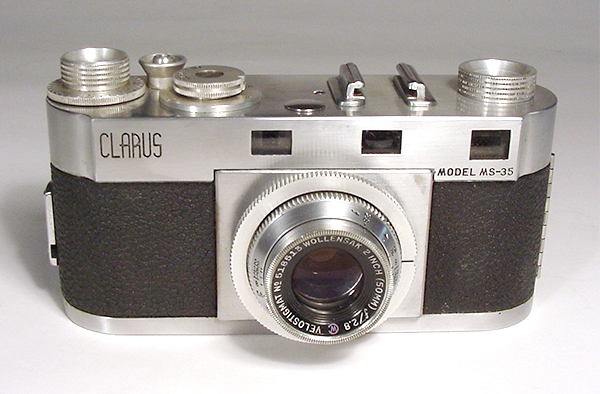
Clarus MS-35 Camera

The Clarus model MS-35 camera was made and sold by the Clarus Camera Manufacturing Company of Minneapolis, Minnesota USA between 1946 and 1952. The MS-35 was the only camera model manufactured by Clarus.
The MS-35 is a full-frame 35mm coupled-rangefinder camera featuring interchangeable lenses and a cloth focal plane shutter with speeds of 1/25 to 1/1000 second, plus bulb. The viewfinder and rangefinder eyepieces are separated. In use, the eye needs to be shifted from one eyepiece to the other for framing and focus — a common feature in cameras of this vintage. The viewfinder shows only the field of view for the standard 50mm lens. There is no parallax correction, nor parallax marks.
The lens on this camera is the frequently seen Wollensak Velostigmat 2 inch f/2.8, with stops to f/16. A telephoto and wide-angle lens were available in the unique Clarus screw-mount, as well as a 50mm f/2.0 lens. Clarus mount lenses I am aware of are an Elgeet 4 inch telephoto, Wollensak 101mm f/3.5 telephoto, Wollensak 35mm f/3.5 wide-angle and a Wollensak Raptar 2 inch f/2.0 lens.
The shutter speed dial rotates during exposure and must be lifted for setting, another feature common to many cameras of the late 1940s. The camera does not have a self-timer, and this example does not have flash synchronization. Clarus added new features and made various cosmetic changes to the MS-35 during its short life-span. Later models are synchronized for flash.
The frame counter is the manual-reset type. In practice, the film advance is a bit awkward, as the shutter release guard is positioned too close to the advance knob for comfort. The shutter release also serves as a film rewind button and must be continuously depressed while rewinding.
I think the accessory shoe deserves merit for style. Rather than settle for the almost universal design of a single piece of bent sheet metal, Clarus developed a truly unique shoe. The two sides are separately mounted castings — subtle and stylish. Earlier models are adorned with this unique accessory shoe. Late models have the common, unimaginative style shoe found on other cameras.

Stylish as the accessory shoe may be, the MS-35 cannot escape its reputation as a troublesome camera of dubious quality. I have never read a glowing review of its virtues. My first experience with a Clarus was not positive. My camera actually functioned, but image quality was poor and the shutter was not acceptably accurate. To be fair, it is reported that Clarus worked out the bugs in its design, but too late to win back customers. I have since restored a number of MS-35 cameras and discovered that when they are properly cleaned and adjusted results are far better than my first experience.
I bought my first MS-35 from a pawn shop at the age of twelve for ten dollars. Frankly, the Brownie camera I'd borrowed from my mother made better photographs than the MS-35. But it was fun for a twelve year old to play with, and when I again saved my money for a better quality camera, I took the Clarus apart. That was fun! Unfortunately that first Clarus was destroyed in a minor house fire. So for sentimental reasons I later purchased my second Clarus.
I think the Clarus is a handsome camera, in a Detroit sort of way. It certainly is bulkier, cruder and heavier than a comparable Leica IIIc of the period. The May, 1951 issue of Popular Photography lists the MS-35 at 116.25 USD with the f/2.8 lens, or 168.50 USD with the f/2.0 Raptar. In the same issue of Popular Photography, the Leica IIIc camera was advertised at 259.00 USD with f/3.5 lens and 350.00 USD with f/2.0 lens. Yes, the Leica was expensive — twice as expensive. But then purchasing a Leica meant buying only one camera. Purchasing a Clarus meant buying two — the Clarus and its replacement.
Still, I am fond of my "new" Clarus. It has character and a stylish accessory shoe.


The Clarus pictured above is an early design variation. There are many striking cosmetic differences between the earliest MS-35 cameras and later improved versions. This early example sports strap lugs, viewfinder bezels, and a sliding back latch. Later versions dropped the strap lugs and bezels. The sliding back latch was changed to a twist-to-open latch. The early shutter speed setting dial is styled after the Leica dial. Shutter speeds are engraved on the dial, whereas on later MS-35s, speeds are engraved on a plate surrounding the speed dial.
Other noticeable differences in the early version include: diamond knurl pattern on the wind and rewind knobs, different styling to the shutter release guard and an engraved nameplate surrounding the shutter speed dial. The early frame counter dial has long lines engraved for each frame. Later frame counters have short engraved lines, giving the dial a cleaner appearance. Surprisingly, the early frame counter dial is not knurled. Knurling was added to later versions. The lack of knurling makes it almost impossible to grip and rotate the frame counter. This is necessary to zero the counter when loading film. Also notice the words Made In U.S.A below the Clarus name. I believe only MS-35s with the strap lug top-plate bore this engraving. On all of my early Clarus cameras, there is a missing period after A in the U.S.A. abbreviation.
As the early MS-35 quickly developed a reputation of unreliability, Clarus made important internal design improvements to their camera. The shutter mechanism was simplified somewhat, and given greater adjustment for wear.
I have found a surprising number of variants — more than I'd expected. See the Major Features page for images of a number of Clarus design variations.
Here is a link to research into Clarus camera serial numbers.

|
Page created August 6, 2001;
updated December 20, 2020 |